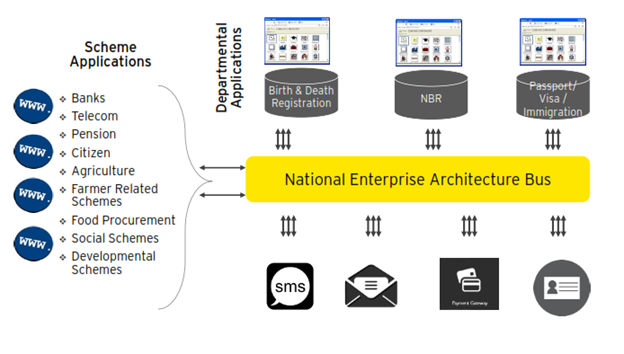E-Services are a critical component for establishing e-Government. All government entities are currently engaged in provided electronic services or e-services to the citizens and business. E-Services are the final outcome from BNDA (Bangladesh National Digital Architecture). The BNDA framework, principles, standards, guidelines, software, tools and infrastructure would be used to develop better, improved, accessible and reusable e-Services by government organizations. E-Services would include government-to-government (G2G) or government-to-citizen (G2C) or government-to-business (G2B) or government-to-employee (G2E).
The Government has introduced National e-Service Bus under Bangladesh National Digital Architecture (BNDA) framework to ensure interoperability, availability and reusability of government online services, information and data. National e-Service Bus is software driven middleware platform which is being developed keeping a provision to enable online services, sharing of information and data of ministries, departments and directorates to ensure interoperability and end user’s easy access to it.
E-service Bus and Different Govt applications/services

National e-Service bus is a critical component in the interoperability architecture domain and key to ensuring seamless exchange of information and services for Government of Bangladesh. Considering the scope and span of National e-Service bus, due procedures and guidelines have been established around the governance to ensure robust and standardized controls are being followed by the BNDA working team. National e-Service bus is based on service oriented architecture paradigm. The service definition and deployment lifecycle has been covered and due procedures including the roles and responsibilities defined for the benefit of the SOA (Service-Oriented Architecture) team working on National e-Service bus. As a part of BNDA phase 1 conceptualization, couple of e-Services have been developed on the BNDA components (National e-Service bus, service delivery platform and national data center cloud). The individual software components comprising of these e-services would be made available to other government organizations to enable faster software development time and reduce development costs.
e-services that are already integrated (not limited to) with e-service bus:
| Service/System Name | Owner Organization |
|---|---|
| NID system | Bangladesh Election Commission (BEC) |
| Birth & Death Registration system | Office of Registrar General |
| Pay-Fixation System | Finance Division |
| e-Primary System | Directorate of Primary Education (DPE) |
| Blockchain Platform | BCC |
| GeoDASH Platform | BCC |
| Data Analytics Platform | BCC |
Organizations who are consuming services from e Service Bus:
| Service/System Name | Owner Organization |
|---|---|
| eRecruitment System | BCC |
| Digital Service Book System | Directorate of Primary Education (DPE) |
| Foodgrain Procurement management System | DG Food Office |
| Digital Municipality Service System | BCC |
| NTMC (National Telecom Monitoring System) Application system | NTMC |
| TMS (Training management System) | A2I, Ministry of Land |
| e-Mutation System | BCC |
| Ek-Sheba Sarkar | A2I |
| ISDP (Integrated Service delivery Platform) | A2I, MSW |
| e-KYC system | A2I, Bangladesh Bank |
| e-Nothi Application | A2I |
| GRS (Grievance Redressal System) | A2I, Cabinet Division |
| ekPay – payment gateway | A2I, Bangladesh bank |
| LISF (Land Information and Service framework) | A2I, Ministry of Land |
| NDC (National Data center) Help Desk System | BCC |
| Integrated Digital Service Delivery Platform | MOST (Ministry of Science & Technology) |
| Disability Dtetection Survey system | DSS |
| Online Tax Return | NBR |
| Issuance of Digital signature(e-sign) | BCC |
| Electronic Construction Permit | RAJUK |
| e-GP application | CPTU |
| Porichoy.gov.bd | DGSL |
| MyGov platform | A2I |
| Integrated Service Delivery Platform | Ministry of Social Services |
| National Job Portal | BCC |
More applications and services are in pipeline to be integrated with national e-service bus shortly. National e-service bus is built with Open source tools/technologies. We are using WSO2 product suite (API manager, ESB, Identity Server, Governance Registry, Data Analytics server etc), these are based on SOA architecture. More over:
- BNDA design and standards have been used to build the foundation architecture for the three E-services
- All of the e-services are registered on the National e-Service Bus
- The three e-Services uses common technology and programming languages
- They are using the same business automation and workflow engine
- Common reporting engine has been used to meet the backend reporting requirements
- They are hosted on shared cloud infrastructure (BCC national data center)
For example, citizen authentication is a foundation building block used by all these three e-Services. A citizen is required to be authenticated against NID database for job application, a farmer needs to be authenticated to be eligible for selling grains to government and teachers are required to establish their identity through national identity. Hence all the three e-services require authentication of a citizen against the NID database.